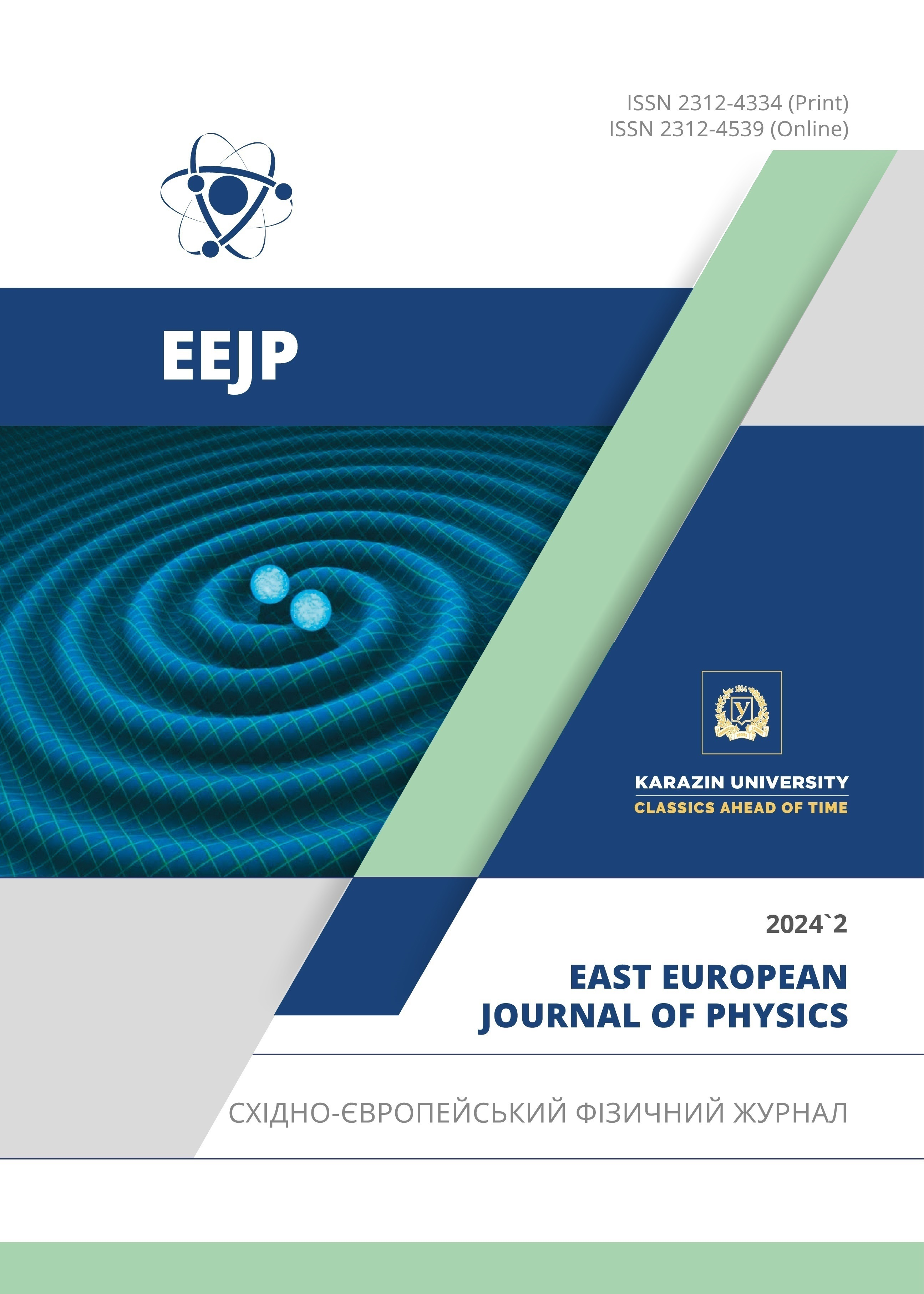Дослідження впливу легування кремнію гольмієм на його структуру та властивості методами спектроскопії
Анотація
Кожна кристалічна структура має власні фононні моди, які з’являються в спектрі комбінаційного розсіювання. У випадку кремнію можна виявити фононні моди, пов'язані з алмазною структурою кремнію. У раманівському спектрі зазвичай вимірюють положення ліній, їх інтенсивність і ширину ліній. Раманівська спектроскопія є потужним інструментом для вивчення кристалічних матеріалів на молекулярному рівні, і її застосування у вивченні напівпровідників і наноматеріалів дає важливу інформацію про їх структуру та властивості. У даній роботі проаналізовано спектри двох типів кремнію: n-Si та p-Si, а також їх легованих аналогів n-Si<Ho> та p−Si<Ho>. Отримані результати комбінаційного зображення продемонстрували просторово змінну нанокристалічність і мікрокристалічність зразків. Спектри n-Si<Ho> та p-Si<Ho> вказують на появу раманівської смуги при 525 см-1 зі зсувом на -5 см-1 та +5 см-1 відповідно відносно положення пік кремнієвої підкладки, що вказує на наявність деформації розтягу в матеріалах. Відсутність інших домішкових піків свідчить про високу чистоту зразків n-Si<Ho> та p-Si<Ho>. Si-матеріал, легований гольмієм, демонструє додаткові піки в спектрах комбінаційного розсіювання, що пояснюється наявністю вакансій і дефектів у новоутворених композиціях Si-Ho. Результати аналізу спектрів свідчать про вплив легування кремнію гольмієм на його структуру та властивості, утворення нових зв'язків і дефектів.
Завантаження
Посилання
Sh.B. Utamuradova, Kh.J. Matchonov, J.J. Khamdamov, and Kh.Y. Utemuratova, “X-ray diffraction study of the phase state of silicon single crystals doped with manganese,” New Materials, Compounds and Applications, 7(2), 93-99 (2023). http://jomardpublishing.com/UploadFiles/Files/journals/NMCA/v7n2/Utamuradova_et_al.pdf
Y. Inoue, S. Nakashima, A. Mitsuishi, T. Nishimura, and Y. Akasaka, “The Depth Profiling of the Crystal Quality in Laser-Annealed Polycrystalline Si Films by Raman Microprobe,” Jpn. J. Appl. Phys. 25, 798–801 (1986). https://doi.org/10.1143/JJAP.25.798
Sh.B. Utamuradova, Sh.Kh. Daliev, D.A. Rakhmanov, S.F. Samadov, and A.S. Doroshkevich, “Investigation of radiation defect formation of irradiated n-Si,” Advanced Physical Research, 5(3), 183-191 (2023). http://jomardpublishing.com/UploadFiles/Files/journals/APR/V5N3/7.Utamuradova.pdf
Sh.B. Utamuradova, Sh.Kh.Daliev, A.V. Stanchik, D.A. Rakhmanov, “Raman spectroscopy of silicon, doped with platinum and irradiated by protons”, E3S Web of Conferences, 402, 14014(2023). https://doi.org/10.1051/e3sconf/202340214014
Z.T. Azamatov, Sh.B.Utamuradova, M.A. Yuldoshev, N.N. Bazarbayev, “Some properties of semiconductor-ferroelectric structures”, East European Journal of Physics, 2, 187–190(2023). https://doi.org/10.26565/2312-4334-2023-2-19
Daliev, Kh.S., Utamuradova, Sh.B., Khamdamov, J.J. & Bahronkulov, Z.E. (2024). Electrophysical properties of silicon doped with lutetium. Advanced Physical Research, 6(1), 42-49 https://doi.org/10.62476/apr61.49
V. A. Volodin, M. D. Efremov, and V. A. Gritsenko, “Raman Spectroscopy Investigation of Silicon Nanocrystals Formation in Silicon Nitride Films,” Solid State Phenom. 57-58, 501–506 (1997). https://doi.org/10.4028/www.scientific.net/SSP.57-58.501
Sh.B.Utamuradova, Z.T. Azamatov, M.A. Yuldoshev, “Optical Properties of ZnO–LiNbO3 and ZnO–LiNbO3:Fe Structures”, Russian Microelectronics, 52, 99–103(2023). https://doi.org/10.1134/S106373972360022X
H. Xia, Y.L. He, L.C. Wang, W. Zhang, X.N. Liu, X.K. Zhang, D. Feng, and H.E. Jackson, “Phonon mode study of Si nanocrystals using micro‐Raman spectroscopy,” J. Appl. Phys. 78, 6705–6708 (1995). https://doi.org/10.1063/1.360494
Z. Iqbal, and S. Veprek, “Raman scattering from hydrogenated microcrystalline and amorphous silicon,” J. Phys. C, 15, 377 (1982). https://doi.org/10.1088/0022-3719/15/2/019
J. Gonzales-Hernandez, G.H. Azarbayejani, R. Tsu, and F.H. Pollak, “Raman, transmission electron microscopy, and conductivity measurements in molecular beam deposited microcrystalline Si and Ge: A comparative study,” Appl. Phys. Lett. 47, 1350 (1985). https://doi.org/10.1063/1.96277
I.H. Campbell, and P.M. Fauchet, “The effects of microcrystal size and shape on the one phonon Raman spectra of crystalline semiconductors,” Solid State Commun. 52, 739 (1986). https://doi.org/10.1016/0038-1098(86)90513-2
J.E. Smith, Jr., M.H. Brodsky, B.L. Crowder, M.I. Nathan, and A. Pinczuk, “Raman Spectra of Amorphous Si and Related Tetrahedrally Bonded Semiconductors,” Phys. Rev. Lett. 26, 642 (1971). https://doi.org/10.1103/PhysRevLett.26.642
Kh.S. Daliev, Sh.B. Utamuradova, Z.E. Bahronkulov, A.Kh. Khaitbaev, and J.J. Hamdamov, “Structure Determination and Defect Analysis n-Si, p-Si Raman Spectrometer Methods,” East Eur. J. Phys. 4, 193 (2023). https://doi.org/10.26565/2312-4334-2023-4-23
P.A. Temple, and C.E. Hathaway, “Multiphonon Raman spectrum of silicon,” Physical Review B, 7(8), 3685–3697 (1973). https://doi.org/10.1103/PhysRevB.7.3685
Sh.B. Utamuradova, Sh.Kh. Daliev, E.M. Naurzalieva, X.Yu. Utemuratova, “Investigation of defect formation in silicon doped with silver and gadolinium impurities by raman scattering spectroscopy”, East European Journal of Physics, 3, 430–433(2023). https://doi.org/ 10.26565/2312-4334-2023-3-47
K.J. Kingma, and R.J. Hemley, “Raman spectroscopic study of microcrystalline silica,” American Mineralogist, 79(3-4), 269 273 (1994). https://pubs.geoscienceworld.org/msa/ammin/article-pdf/79/3-4/269/4209223/am79_269.pdf
G.E. Walrafen, Y.C. Chu, and M.S. Hokmabadi, “Raman spectroscopic investigation of irreversibly compacted vitreous silica,” The Journal of Chemical Physics, 92(12), 6987–7002 (1990). https://doi.org/10.1063/1.458239
B. Champagnon, C. Martinet, M. Boudeulle, D. Vouagner, C. Coussa, T. Deschamps, and L. Grosvalet, “High pressure elastic and plastic deformations of silica: in situ diamond anvil cell Raman experiments,” Journal of Non-Crystalline Solids, 354(2-9), 569–573 (2008). https://doi.org/10.1016/j.jnoncrysol.2007.07.079
Авторське право (c) 2024 Шаріфа Б. Утамурадова, Шахрух Х. Далієв, Алішер Х. Хаитбаєв , Джонібек Дж. Хамдамов, Хусніддін Дж. Матчонов, Хусніда Й. Утемуратова

Цю роботу ліцензовано за Міжнародня ліцензія Creative Commons Attribution 4.0.
Автори, які публікуються у цьому журналі, погоджуються з наступними умовами:
- Автори залишають за собою право на авторство своєї роботи та передають журналу право першої публікації цієї роботи на умовах ліцензії Creative Commons Attribution License, котра дозволяє іншим особам вільно розповсюджувати опубліковану роботу з обов'язковим посиланням на авторів оригінальної роботи та першу публікацію роботи у цьому журналі.
- Автори мають право укладати самостійні додаткові угоди щодо неексклюзивного розповсюдження роботи у тому вигляді, в якому вона була опублікована цим журналом (наприклад, розміщувати роботу в електронному сховищі установи або публікувати у складі монографії), за умови збереження посилання на першу публікацію роботи у цьому журналі.
- Політика журналу дозволяє і заохочує розміщення авторами в мережі Інтернет (наприклад, у сховищах установ або на особистих веб-сайтах) рукопису роботи, як до подання цього рукопису до редакції, так і під час його редакційного опрацювання, оскільки це сприяє виникненню продуктивної наукової дискусії та позитивно позначається на оперативності та динаміці цитування опублікованої роботи (див. The Effect of Open Access).








